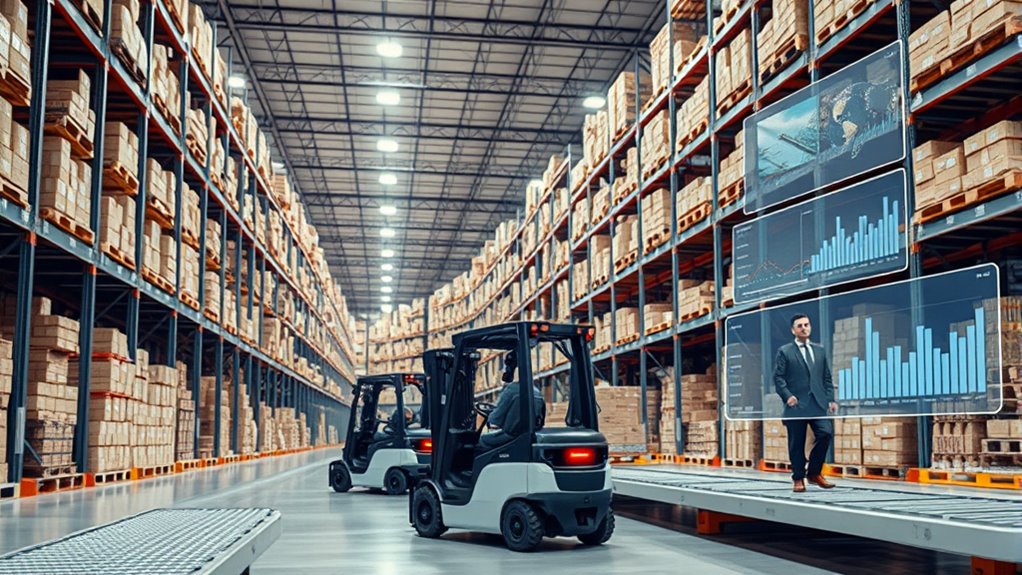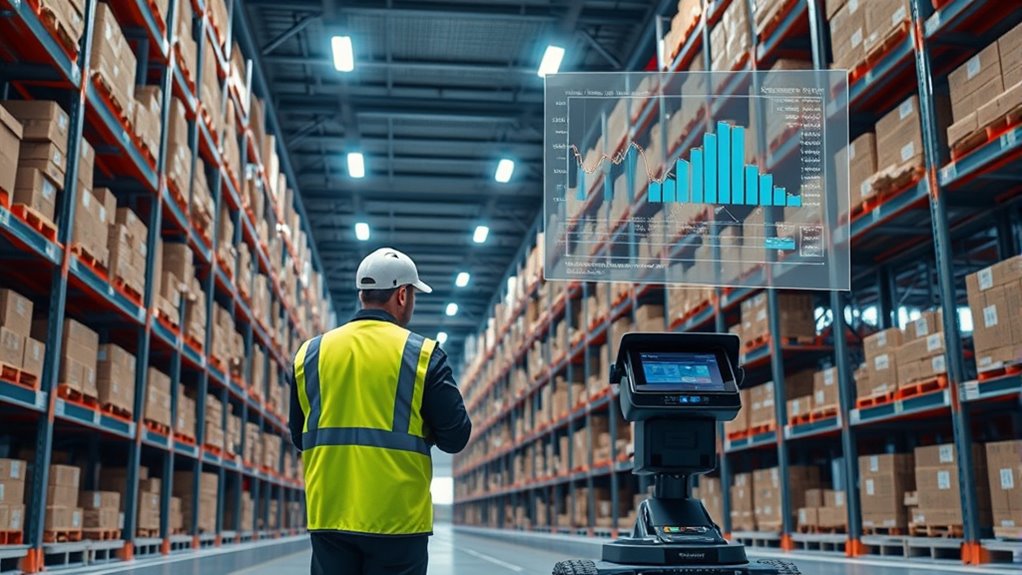AI can greatly optimize your warehouse operations by automating tasks with robotics, reducing errors, and speeding up processes such as inventory management and order fulfillment. It analyzes real-time data to forecast demand, detect disruptions, and improve routing. AI also boosts security and helps track inventory precisely, cutting costs and waste. By integrating these advanced technologies, you’ll see higher efficiency and smoother supply chains. Keep exploring how AI can transform your warehouse for more innovative solutions.
Key Takeaways
- Automates product retrieval, inventory checks, and order fulfillment with AI-powered robotics for increased speed and accuracy.
- Utilizes real-time data analysis and machine learning to forecast demand and optimize restocking processes.
- Enhances security and inventory tracking through sensors and advanced monitoring technologies.
- Streamlines route planning and resource allocation, reducing labor strain and improving throughput.
- Supports sustainability and risk mitigation by optimizing space, reducing waste, and proactively managing disruptions.

Artificial Intelligence is revolutionizing warehouse operations by automating tasks, optimizing inventory, and boosting efficiency. As a result, you can expect smoother workflows, reduced manual effort, and faster delivery times. AI-driven systems analyze vast amounts of data in real-time, allowing you to make smarter decisions, predict inventory needs, and prevent stockouts or overstocking. This level of insight helps you stay ahead of demand fluctuations and enhances your overall supply chain agility. With AI, your warehouse becomes more responsive, resilient, and cost-effective, giving you a competitive edge.
AI transforms warehouses with smarter decisions, real-time data, and improved efficiency for a competitive edge.
One of the most visible innovations is AI-powered robotics, such as automated guided vehicles (AGVs) and drones. These robots navigate warehouses autonomously, retrieving products, conducting inventory checks, and fulfilling orders with remarkable speed and accuracy. By automating these repetitive and often hazardous tasks, you reduce the risk of human error and free your staff to focus on more complex activities. The precision of these robots means fewer mistakes in order picking and inventory management, which directly translates into higher customer satisfaction.
Advanced data analytics further enhances your warehouse operations. AI tools monitor inventory status in real-time, providing insights into stock levels and product trends. With machine learning models, you can forecast demand more accurately, optimize restocking schedules, and identify potential supply chain disruptions before they happen. This proactive approach minimizes delays and keeps your operations running smoothly. AI also streamlines routing and order fulfillment processes, ensuring that your products reach customers faster and more reliably. Incorporating real-time data analysis can further improve decision-making and operational responsiveness. Moreover, AI’s evolving capabilities are continuously improving security measures, helping to prevent theft and unauthorized access in your warehouse environment. Additionally, integrating advanced sensor technology enhances the precision of inventory tracking and environmental monitoring, further improving efficiency.
Operational efficiency sees a significant boost through AI automation. Tasks like order picking and inventory management are optimized to reduce labor strain and improve throughput. By analyzing large data sets, AI uncovers patterns that help you refine workflows, allocate resources more effectively, and adjust operations proactively. This not only cuts costs but also maintains high service levels, even during peak periods. AI-driven supply chain optimization allows you to plan better routes, anticipate demand changes, and respond swiftly to global disruptions, making your supply chain more resilient.
Sustainability and risk management are also strengthened by AI. You can optimize space usage, reduce waste, and minimize energy consumption in your warehouse. Additionally, AI’s predictive capabilities help identify potential risks, allowing you to take preventative measures and avoid costly disruptions. For example, integrating detailed inventory data enables more precise stock management and reduces excess inventory. AI’s ability to adapt to changing conditions ensures your warehouse remains future-proof in a rapidly evolving marketplace. Overall, AI empowers you to build a smarter, more sustainable, and adaptable warehouse that aligns with modern demands and future growth.
Frequently Asked Questions
How Does AI Improve Inventory Accuracy in Warehouses?
You want to know how AI improves inventory accuracy in warehouses. AI collects real-time data from various sources, making inventory levels more visible and precise. It also validates data automatically, detects anomalies early, and predicts future needs. By automating tracking and verifying stock levels, AI reduces manual errors, guarantees accurate order fulfillment, and helps you optimize inventory levels. This results in fewer discrepancies, better stock management, and increased overall efficiency.
What Are the Initial Costs of Implementing AI Solutions?
You’re curious about the initial costs of AI solutions, and it’s a mix of hefty investments and strategic spending. While AI software development can range from $50,000 to over $500,000, don’t forget the costs for data infrastructure, hardware upgrades, and integration. Depending on your industry—healthcare, finance, retail, or logistics—expenses vary, but upfront investment paves the way for long-term efficiency, cost savings, and smarter decision-making.
How Does AI Handle Unexpected Disruptions in Warehouse Operations?
When unexpected disruptions happen, AI kicks in by monitoring operations in real-time and analyzing data to predict issues early. You get automated alerts to act swiftly, and AI manages inventory dynamically, ensuring minimal impact. It optimizes workflows, detects hazards, and adjusts logistics on the fly. By constantly adapting, AI helps you maintain safety, efficiency, and resilience, even when surprises threaten to derail your warehouse operations.
What Training Is Required for Staff to Use AI Systems Effectively?
You need extensive training to use AI systems effectively. Start by understanding how to operate AI tools like robots and computer vision systems. Learn how to interpret data insights and troubleshoot issues. Practice adapting to workflow changes through simulations or VR. Develop skills in data analysis and integration with existing management systems. Continuous learning and feedback are vital to stay updated, ensuring you can leverage AI to improve efficiency and solve problems confidently.
How Secure Is Sensitive Warehouse Data When Using AI Technologies?
You should know that 40% of organizations have faced privacy breaches related to AI, with a quarter of these being malicious. When you use AI technologies, your sensitive warehouse data faces high risks from cyber threats like malware and phishing. While measures like multi-factor authentication help, vulnerabilities evolve rapidly—new issues emerge every 17 minutes—making it essential to stay vigilant and implement robust security protocols to protect your data effectively.
Conclusion
Implementing AI in your warehouse can boost efficiency considerably—studies show that AI-driven logistics can reduce operational costs by up to 25%. By leveraging real-time data and predictive analytics, you can streamline inventory management, minimize errors, and improve delivery times. Embracing AI isn’t just a trend; it’s a smart move to stay competitive. So, take advantage of these advancements now and watch your warehouse operations become more agile, accurate, and cost-effective than ever before.











